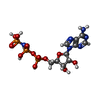+Search query
-Structure paper
| Title | Atomic model for the dimeric F region of mitochondrial ATP synthase. |
|---|---|
| Journal, issue, pages | Science, Vol. 358, Issue 6365, Page 936-940, Year 2017 |
| Publish date | Nov 17, 2017 |
 Authors Authors | Hui Guo / Stephanie A Bueler / John L Rubinstein /  |
| PubMed Abstract | Mitochondrial adenosine triphosphate (ATP) synthase produces the majority of ATP in eukaryotic cells, and its dimerization is necessary to create the inner membrane folds, or cristae, characteristic ...Mitochondrial adenosine triphosphate (ATP) synthase produces the majority of ATP in eukaryotic cells, and its dimerization is necessary to create the inner membrane folds, or cristae, characteristic of mitochondria. Proton translocation through the membrane-embedded F region turns the rotor that drives ATP synthesis in the soluble F region. Although crystal structures of the F region have illustrated how this rotation leads to ATP synthesis, understanding how proton translocation produces the rotation has been impeded by the lack of an experimental atomic model for the F region. Using cryo-electron microscopy, we determined the structure of the dimeric F complex from at a resolution of 3.6 angstroms. The structure clarifies how the protons travel through the complex, how the complex dimerizes, and how the dimers bend the membrane to produce cristae. |
 External links External links |  Science / Science /  PubMed:29074581 / PubMed:29074581 /  PubMed Central PubMed Central |
| Methods | EM (single particle) |
| Resolution | 3.6 - 7.4 Å |
| Structure data | EMDB-7036, PDB-6b2z:  EMDB-7037: |
| Chemicals |  ChemComp-ANP:  ChemComp-MG: |
| Source |
|
 Keywords Keywords | MEMBRANE PROTEIN / Complex / Dimer / Mitochondrial inner membrane / Proton translocation / Proton transporter |
 Movie
Movie Controller
Controller Structure viewers
Structure viewers About Yorodumi Papers
About Yorodumi Papers








